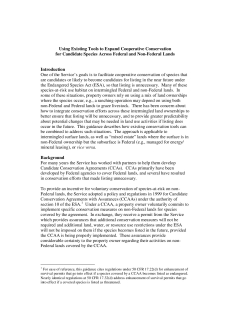
One of the Service’s goals is to facilitate cooperative conservation of species that are candidates or likely to become candidates for listing in the near future under the Endangered Species Act (ESA), so that listing is unnecessary. Many of these species-at-risk use habitat on intermingled Federal and non-Federal lands. In some of these situations, property owners rely on using a mix of land ownerships where the species occur, e.g., a ranching operation may depend on using both non-Federal and Federal lands to graze livestock. There has been concern about how to integrate conservation efforts across these intermingled land ownerships to better ensure that listing will be unnecessary, and to provide greater predictability about potential changes that may be needed in land use activities if listing does occur in the future. This guidance describes how existing conservation tools can be combined to address such situations. The approach is applicable to intermingled surface lands, as well as “mixed estate” lands where the surface is in non-Federal ownership but the subsurface is Federal (e.g., managed for energy/ mineral leasing), or vice versa.
| Attachment | Size |
|---|---|
| CCA-CCAA-Final-Guidance.pdf74.11 KB | 74.11 KB |
